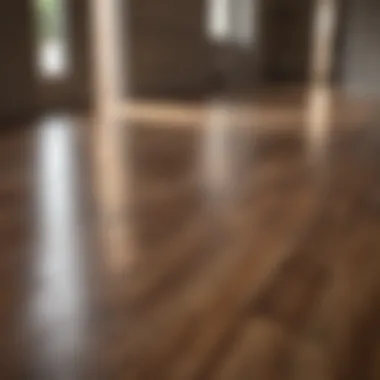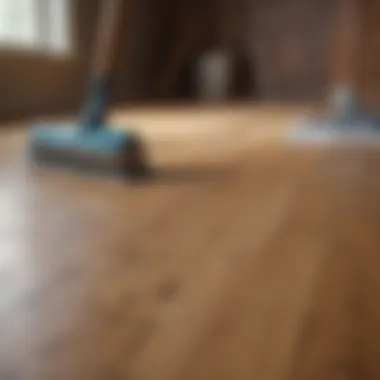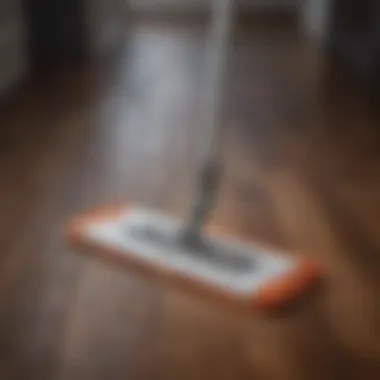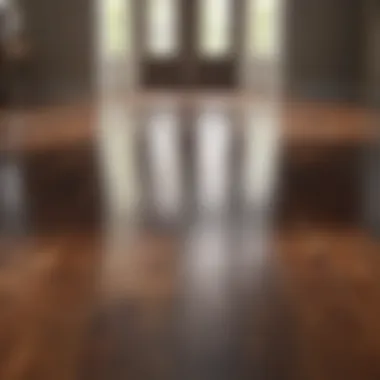Effective Techniques for Maintaining Hardwood Floors


Intro
Maintaining the beauty of hardwood floors is not just a chore; it's an essential part of home ownership that speaks volumes about your commitment to creating a welcoming atmosphere. As homeowners or design enthusiasts, the floors in your living space play a crucial role in the overall aesthetic appeal. They can elevate the look of a room or subtly add warmth and sophistication. However, with the daily wear and tear, it can be a challenge to keep them looking pristine.
Cleaning hardwood floors involves understanding their unique characteristics and the kind of treatment they require.
Key Points Covered
- Techniques and practices in cleaning hardwood floors
- Recommendations for cleaning tools and agents
- Common mistakes to avoid for effective maintenance
- Expert tips to promote longevity of hardwood floors
Each of these elements plays a pivotal role in enhancing your space’s aesthetic value. So let’s stitch together the details and insights that will allow you to keep your hardwood floors not only clean but also looking marvelous for years to come.
Understanding Hardwood Floors
When it comes to maintaining the elegance of a home, understanding hardwood floors is crucial. These floors aren't just wooden slabs glued to a surface; they represent an investment that can enhance not only the aesthetic appeal but also the overall value of a property. Knowing the characteristics, types, and cleaning requirements can indicate the difference between a polished space and one that looks worn and tired.
In this section, we will explore several elements that contribute significantly to the longevity and upkeep of hardwood flooring, paving the way for effective cleaning methods that will preserve their beauty.
Types of Hardwood Flooring
Hardwood flooring typically falls into two main categories: solid and engineered. Solid hardwood is made from a single piece of wood, providing durability. Engineered hardwood, on the other hand, consists of layers of wood, making it more resistant to humidity and temperature changes. Each type has its own virtues and limitations, influencing the cleaning approach.
- Solid Hardwood: Well-suited for living areas and is less adaptable to moisture.
- Engineered Hardwood: Ideal for basements and areas with fluctuating humidity.
The choice between solid and engineered can affect not just installation but also the cleaning methods, as the finishes on these types may require different care.
Properties and Durability
Understanding the properties of hardwood is essential for proper maintenance. Hardwoods like oak, maple, and cherry offer varying levels of hardness, density, and resistance to scratches or dents. Knowing the hardness of your specific flooring can influence how you tackle cleaning processes.
- Hardness: A more durable species may tolerate aggressive cleaning methods, whereas softer woods will require gentler handling.
- Finish: The type of finish—oil-based or water-based—affects not just the aesthetic but also the cleaning methods. Oil finishes may need different cleaning solutions than urethane finishes.
Being aware of these factors helps one to select the right cleaning technique to avoid damaging the floors.
Importance of Proper Cleaning
Cleaning hardwood floors is not simply a matter of appearance; it's essential for the long-term health of the wood. Dust and dirt can cause tiny scratches that may accumulate over time, leading to a dulled finish. Regular cleaning can prevent buildup and perpetuates the wood's natural beauty. It also minimizes allergens, making for a healthier living environment.
"Neglecting to clean your hardwood floors can lead to costly refinishing later on. A little time spent now can save you exponential effort down the road."
In summary, understanding hardwood floors involves recognizing the types, properties, and cleaning needs specific to your flooring. This knowledge empowers homeowners to select the optimal cleaning methods that not only sustain elegance but also protect their investment for years to come.
Essential Tools for Cleaning
Cleaning hardwood floors effectively requires the right tools. Using appropriate equipment not only helps in maintaining the aesthetic appeal of your floors but also extends their lifespan. In the world of hardwood floor upkeep, selecting quality tools is paramount. A well-stocked cleaning arsenal provides efficiency and ease, allowing for seamless cleaning sessions, whether you're dealing with occasional dust or everyday grime.
Mops and Microfiber Cloths
When cleaning hardwood floors, you can't go wrong with a good mop, especially one designed to handle delicate surfaces. Microfiber mops are a top pick due to their ultra-soft texture that won’t scratch your floors. They effectively trap dirt and dust, and unlike traditional mops, they don’t require excessive water.
- Benefits of Microfiber Mops:
- Dust Trapping: The fibers attract and lock dirt making it less likely to smear.
- Washable: You can easily toss them in the wash, making them reusable and cost-effective.
- Versatile: Fits into tight spots that other mops might struggle with.
A common mistake some users make is opting for heavy-duty mops meant for tile or vinyl flooring. Using a well-suited mop designed for hardwood keeps your floor intact and gleaming without the risk of damage, ensuring your home remains inviting.
Vacuum Cleaners vs. Broom


This is often a bone of contention among cleaning aficionados. Do you reach for a vacuum cleaner or grab a broom? While both can do the job, vacuum cleaners tend to have an edge when it comes to keeping hardwood floors pristine.
- Vacuum Cleaners:
- Broom:
- Effective on Debris: Sucks up dirt, crumbs, and dust bunnies without spreading them around.
- Attachments Available: Many modern vacuums come with attachments specifically for hardwood; these ensure no scratching or marring occurs.
- Quick and Efficient: Cuts down on time needed to get a clean sweep of your floors.
- Suitable for Quick Pick-Ups: Great for a fast job when you’re in a hurry.
- Less Noise: Ideal for quiet cleaning sessions without the hum of a vacuum.
- No Power Needed: Always handy, especially during a power outage.
In essence, if you're serious about maintaining the condition of your hardwood floors, investing in a quality vacuum cleaner might be the way to go, provided you choose the right model.
Cleaning Solutions: What to Use
When it comes to cleaning solutions, tread carefully — not all products are suited for hardwood. Using the wrong solution can lead to sticky residues or even damage the finish of your floors.
- Recommended Solutions:
- pH-Neutral Cleaners: These are gentle on wood and won't strip away the finish.
- Homemade Solutions: A simple mix of water and vinegar in the right proportions can be quite effective. Just remember, avoid soaking the floor.
- Commercial Products: Brands like Bona or Murphy's Oil Soap have a strong reputation for catering specifically to hardwood care. Always check for compatibility with your floor type before use.
"Choosing the right cleaning solution is crucial; it can make the difference between a floor that shines and one that shows its age."
Step-by-Step Cleaning Process
Cleaning hardwood floors requires a systematic approach that preserves their beauty and integrity. This section outlines a clear, detailed process that incorporates preparation, dry cleaning, and wet cleaning techniques. Following these steps not only prolongs the life of your floors but also enhances their aesthetic appeal.
Preparation: Clearing the Area
Before grabbing a mop or vacuum, it’s crucial to prep the space. A clean workspace leads to more effective cleaning. Start by moving any furniture and decorative items out of the way. This ensures you cover every inch of the floor and prevents damage to your prized possessions.
- Check for Items To Move: Things like rugs, plants, and furniture can hide dirt and dust under them. Don’t skip this step; it’s like putting on a clean shirt before leaving the house!
- Make A Stack: Consider creating a designated spot where you can pile items temporarily. This helps you stay organized and makes it easier to put everything back where it belongs once the cleaning is done.
Taking a few moments to clear the area not only makes cleaning smoother but also enhances your focus. Trust me, when you see that spotlessly clean floor, it’ll be worth the trouble.
Dry Cleaning Techniques
Once the area is clear, it’s time to tackle the dry dirt. Dry cleaning is significant because it removes larger particles that can scratch the surface during wet cleaning. Here’s how to do it:
- Sweep or Vacuum: Use a soft-bristle broom or a vacuum designed for hardwood floors. Avoid vacuums with beater bars, as these can be too harsh on the finish. If you’d rather sweep, make sweeping motions in a direction that follows the grain of the wood. This helps minimize scratches.
- Microfiber Cloth: For those hard-to-reach spots or tight corners, a microfiber cloth can work wonders. It’s effective for picking up dust and grime without causing damage. Just glide it along baseboards or in corners where your vacuum might not reach.
- Dusting Tools: If you have textured floors, consider using a dust mop with a fluffy head. It can grab dirt and particles that a broom may leave behind. Make sure it's designed for hardwood to avoid any mishaps.
"An ounce of prevention is worth a pound of cure"—keeping a clean floor daily saves you from deep cleaning dilemmas later.
Wet Cleaning Approaches
Now that the floor is free from the bulk of debris, the wet cleaning can begin. Wet cleaning is where you can really bring out the shine in your hardwood. However, it’s important to keep moisture to a minimum to protect the wood’s integrity. Here’s how:
- Choose the Right Cleaner: Select a cleaning solution that is safe for hardwood. Options include specialized hardwood floor cleaners or a mix of vinegar and water. If going the DIY route, a cup of vinegar in a gallon of warm water can do the trick.
- Damp Mopping: Instead of soaking the mop, dampen it lightly before applying it to the floor. Too much water can seep into cracks and seams, causing warping. Ensure you wring out the mop until it’s just slightly damp.
- Work in Sections: Don’t try to cover too much ground at once. Work in small areas, mopping in the direction of the wood grain. This helps remove grime effectively without leaving streaks.
- Dry Immediately: After mopping, make sure to dry the area promptly with a soft, dry cloth or towel. Excessive moisture can spell trouble for hardwood floors and lead to some serious damage down the line.
Using these cleaning methods not only preserves the appearance of your hardwood floors but also strengthens their lifespan. Remember, it's a balancing act of cleanliness and care.
Common Mistakes to Avoid
Cleaning hardwood floors can seem straightforward, but there are several pitfalls that can easily trip up even the most diligent homeowner. Understanding these common mistakes is essential to maintaining the beauty and integrity of your floors. When these errors are avoided, not only can the longevity of the flooring be enhanced, but the overall aesthetic appeal can also shine brighter. Let’s dive into three primary missteps when it comes to hardwood floor cleaning.
Using Excessive Water
One of the biggest blunders many make is using too much water during the cleaning process. Wood is a porous material, and letting it soak in liquid can lead to all kinds of trouble, like warping or damaging the protective finish. A damp mop? Sure! But a soaking wet one? That’s a recipe for disaster.
Excessive water can seep into cracks and seams, promoting the growth of mold and mildew, not to mention it may cause the boards to expand or buckle over time.
Tip: A good rule of thumb is to wring out the mop until it’s just damp. It’s better to err on the side of caution—less is definitely more when it comes to water on hardwood!


Ignoring Manufacturer Guidelines
Ignoring the specific guidelines put forth by the flooring manufacturer can be a slippery slope. Each type of hardwood flooring, whether it be oak, maple, or cherry, has its unique care recommendations, including ideal cleaning products and methods.
Failure to adhere to these instructions could not only lead to unsightly wear, but might void any warranties on your floors. For instance, some manufacturers may recommend a particular cleaning solution or method that’s best suited to their finish. Choosing to ignore this could leave your floor vulnerable to damage that your regular old cleaner can't remedy.
Choosing the Wrong Products
In a world full of enticing products claiming to make cleaning a breeze, it’s easy to get swept away. However, not all cleaners are created equal, especially when it comes to hardwood floors. Some might contain harsh chemicals that can strip away the finish or create a haze on the surface.
It’s crucial to choose products that are specifically labeled for hardwood use. This consideration is vital because the wrong choice can lead to a dull appearance over time, or worse, permanent damage. Always look for pH-balanced solutions that are free of silicone and oil.
By steering clear of these mistakes—overusing water, dismissing manufacturer guidelines, and selecting unsuitable products—you’ll be well on your way to preserving your hardwood floors. Each of these actions ensures not just a cleaner space, but a lasting sheen that showcases the natural beauty of your wood.
Preventative Maintenance Tips
Taking care of hardwood floors is akin to tending to a delicate garden. One can’t simply wait for problems to blossom; proactive measures can yield flourishing results. Preventative maintenance helps preserve both the aesthetic and functional aspects of your flooring, eliminating potential issues before they take root.
Protective Mats and Rugs
One of the simplest yet most effective strategies is using protective mats and rugs at entryways and high-traffic spots. Think about how many times dirt and grit come into your home with each passing day. Those little particles may seem harmless but can scratch and wear down even the finest hardwood surfaces over time.
- Types of Mats: Opt for durable, low-profile mats to avoid bunching that could lead to tripping hazards. Rubber-backed mats tend to grip the floor better.
- Placement: Lay down these mats in spots where shoes often walk, like near doorways or under kitchen chairs. It’s an effortless way to catch dirt right at the threshold.
By investing in mats and rugs, you not only keep debris at bay but also add snag free comfort. It’s like having a welcoming gatekeeper for your lovely flooring.
Regular Dusting and Sweeping
Neglecting to dust and sweep can be a slippery slope towards bigger messes. When soil settles on hardwood floors, it gradually becomes a breeding ground for scratches. Regular dusting and sweeping is essential to keep the surface pristine.
- Frequency: Implementing a daily or every-other-day routine can work wonders. It does not have to be a full-on deep clean, just a light sweep to grab those pesky particles.
- Technique: Use a soft-bristle broom or a microfiber dust mop. Both approaches capture dust effectively without causing harm to the floor finish.
Consistency is key here. Even a few minutes a day can elongate the lifespan of your flooring.
Controlling Humidity and Temperature
Hardwood is alive, and like any living thing, it responds to its environment. Wood expands in high humidity and contracts when it’s dry. This process, repeated over time, can lead to warping and cracking. Therefore, controlling humidity and temperature is a vital part of preventative maintenance.
- Ideal Conditions: Aim to keep indoor humidity levels between 30-50%. If you’re uncertain about your home’s current state, consider investing in a hygrometer.
- Temperature Control: Keeping your home at a steady temperature, ideally between 60-80 degrees Fahrenheit, can help keep the wood in check.
Using dehumidifiers or humidifiers can assist in maintaining these conditions. After all, your hardwood deserves a comfortable home too!
"An ounce of prevention is worth a pound of cure." By taking these small steps, one can prevent costly repairs and keep those hardwood floors looking immaculate for years to come.
When to Seek Professional Help
Cleaning hardwood floors can often be a straightforward task, yet there comes a moment when the average homeowner might find themselves lost or overwhelmed. Knowing when to call in the professionals can save both time and money in the long run. Engaging experts not only alleviates the physical stress of cleaning but also ensures that your floors get the specialized care they may need—preserving both their beauty and integrity.
Signs of Damage or Wear
The first step in deciding whether to enlist the help of flooring professionals is identifying signs that indicate your floors are beyond a simple clean. Look for scratches deeper than the surface, stains that cling like a stubborn houseguest, or warped boards that betray moisture damage. These issues can’t just be brushed aside with a mop; they often require specialized treatments or repairs.
- Common indicators of damage include:
- Deep Scratches: If your floors resemble a battle zone, it's time for a pro.
- Discoloration: Stains that don’t budge or fading that can’t be remedied with your usual wipe-down may require a different touch.
- Loose Boards: If you can hear creaks that accompany loose flooring, that’s a red flag.
Recognizing these early can help prevent more extensive repairs later on. Ignoring these signs often leads to bigger headaches down the road, both in terms of cost and the aesthetic charm of your home.


Deep Cleaning and Refinishing
When your hardwood floors have endured wear and tear over the years, a simple clean may not cut it. Deep cleaning and refinishing are techniques utilized to restore the original beauty of hardwood. Professionals use specialized equipment that handles the grinding and sanding process.
- Benefits of deep cleaning and refinishing:
- Removal of Debris: An expert can extract dirt and grime that isn’t visible to the naked eye.
- Stain Removal: Some stains can prove relentless; professionals have proprietary techniques to eliminate these unsightly marks.
- Refinishing: It’s like giving your floors a spa day—bringing back the shine and luster.
Deciding to refinish your floors may not be a frequent task, which makes it all the more crucial to get it right when the time comes.
Consulting Flooring Experts
Even if you’re devoted to the DIY approach, sometimes a little outside assistance can connect the dots to better results. Consulting with flooring experts can provide insight that goes beyond just cleaning. They offer personalized recommendations tailored to your specific floors and lifestyle needs—considerations that may not cross your mind.
- Reasons to consult a flooring expert:
- Expert Advice: Learn about maintenance products tailored to your specific floor type.
- Cost Estimates: Get clarity on what you'll need to budget for future cleaning or repair efforts.
- Latest Techniques: Experts will keep you posted on best practices—keeping your floors in optimal shape for longer.
"A little advice can go a long way, especially when your hardwood floors are on the line. A consultation could very well save your investment."
Ultimately, seeking professional help isn’t an admission of weakness; it’s a smart step toward ensuring that your hardwood flooring remains a beautiful, lasting feature of your home.
Sustainable Cleaning Practices
Sustainable cleaning practices play a crucial role in maintaining not just the appearance of hardwood floors but also the environment. As homeowners grow more ecologically conscious, it becomes essential to choose methods and materials that reflect a commitment to sustainability. By adopting eco-friendly cleaning solutions and minimizing waste, individuals can promote the longevity of their floors while contributing to a healthier planet.
Eco-Friendly Cleaning Solutions
Using eco-friendly cleaning solutions is a pivotal part of any sustainable cleaning regimen. Traditional cleaning products can contain harsh chemicals, which not only have a detrimental impact on the environment but can also harm indoor air quality. Some suitable alternatives include:
- Vinegar and Water: This classic mix tackles dirt and grime effectively without compromising the floor's finish. A simple solution of one part vinegar to three parts water can do wonders.
- Baking Soda: A natural deodorizer and stain remover, baking soda can be mixed with water to form a paste that tackles tough spots.
- Plant-Based Cleaners: Brands that specialize in green cleaning products often use natural ingredients that are both safe for the home and environmentally friendly.
The benefits of these eco-friendly solutions extend beyond just being gentler on the environment. They also diminish the risk of exposure to toxic substances, fostering a healthier living space for families and pets alike. It’s a win-win: shiny floors and peace of mind about what’s on them.
"Choosing the right cleaning products can safeguard your family's health while enhancing your living environment."
Minimizing Waste in Maintenance
Minimizing waste in the cleaning process is another key aspect of sustainable practices. Homeowners can adopt several strategies to reduce waste while maintaining beautiful hardwood floors:
- Microfiber Cleaning Pads: Instead of disposable pads, which add to landfill waste, opt for machine-washable microfiber cleaning pads. They are not only effective but also serve you repeatedly.
- Dilute Before You Dispose: When using concentrated solutions, mixing them in larger batches can save time and cut down on plastic waste from packaging.
- Tree-Friendly Choices: Opting for products packaged in recyclable materials can also lessen your environmental footprint.
When each cleaning session becomes more efficient and waste-aware, the overall impact on the environment diminishes significantly. Homeowners can still achieve stellar results without contributing to waste accumulation.
Incorporating sustainable practices when cleaning hardwood floors isn't just a trend; it's a commitment to a responsible lifestyle. By choosing eco-friendly solutions and reducing waste, individuals can combine beauty with consciousness, resulting in spaces that are both aesthetically pleasing and environmentally sound.
Finale: The Path to Longevity
Cleaning hardwood floors isn't just about aesthetics; it’s central to preserving the life and value of your investment. Proper maintenance, as detailed throughout this article, can have tremendous benefits.
First and foremost, consistent cleaning helps to prevent damage caused by dirt and debris accumulation. Whatever the style or finish of your hardwood, grit and grime have a way of dulling the shine and may eventually lead to scratches or grooves. Think of the time you invest in maintaining your floors as a protective measure—a stitch in time saves nine, as the saying goes.
Moreover, being mindful of the cleaning products you choose is pivotal. Eco-friendly solutions not only keep harsh chemicals at bay but also contribute positively to the indoor air quality of your space. Many commercial cleaners often contain toxic substances that can linger and pose health risks. Opting for natural ingredients can certainly go a long way—not just for flooring longevity but also for generating a healthier living environment.
In addition, preventative maintenance techniques such as using mats at entryways or adjusting humidity levels in your home should not be underestimated. They act like armor for your floors, guarding against moisture damage or unsightly scuff marks. It’s practical wisdom that pays dividends.
Key Takeaways:
- Routine Care: Regular sweeping and mopping extend the life of the finish.
- Product Awareness: Always check product labels for compatibility with your flooring type.
- Climate Control: Use humidifiers in dry seasons to avoid cracking.
"An ounce of prevention is worth a pound of cure."
Ultimately, your hardwood floors can retain their character and charm with a tad bit of care and foresight. Be it through professional assistance for deep cleans or simply adhering to a sound cleaning regimen on your own, the payoff is clear. Keeping your floors in prime condition not only enhances the beauty of your home but also boosts its real estate value—sustaining that initial investment into the years to come.
The journey to longevity isn't a sprint; it's a marathon. Right steps will ensure beautiful floors that can stand the test of time for generations.















